Seabed Terrain-Aided Navigation Algorithm Based on Combining Artificial Bee Colony and Particle Swarm Optimization
Abstract
1. Introduction
- (1)
- The traditional terrain matching algorithm has limitations on the initial position error and matching time. To this end, the matching algorithm combining ABC and PSO is proposed for INS terrain matching.
- (2)
- In this study, PSO is analyzed in depth, and its ability to find the global optimal solution is improved by modifying the acceleration factor c1. The improved PSO is called adaptive PSO (APSO). Meanwhile, linear decreasing inertia weights are introduced based on APSO to improve the search speed. The new algorithm is named WAPSO, and its convergence is proved.
- (3)
- To strengthen the particle optimization ability of WAPSO, ABC is combined with WAPSO to avoid it falling into the local optimum in later iterations, and the final algorithm is termed ABC search-based WAPSO (F-WAPSO). Subsequently, it is used for terrain matching.
- (4)
- The search area and fitness function are determined according to the requirements of terrain matching navigation. The algorithm’s validity is verified by experiments with real bathymetric data obtained in Weihai.
2. Principle and Model of TAN
2.1. Principle of TAN
2.2. State Space Model of TAN
3. PSO Based on ABC Search (F-WAPSO)
3.1. Improved PSO and Its Convergence Analysis
3.1.1. Improved PSO (WAPSO)
3.1.2. Convergence Analysis of WAPSO
3.2. WAPSO Based on ABC
4. Terrain Matching Search Strategy Based on the F-WAPSO
4.1. Search Area
4.2. Search Strategy
- 1.
- Initialization. Set F-WAPSO parameters and select a population of particles in search space with random positions and velocities.
- 2.
- Calculate each particle’s fitness function value. After the optimization target has been established, that is, the matching sequence of the starting point node represented by the current particle, the search range is determined by Equations (19) and (20). The optimal matching sequence is determined by the minimum MHD sequence between the searched and measured terrain elevation sequences according to this range.
- 3.
- Update the individual optimal solution and the global optimal solution. First, each particle’s current fitness value is compared with the individual optimal solution pbest. If the current fitness value is less than pbest, pbest is updated as the current fitness value of the particle. Second, the current fitness value of each particle is compared with the global optimal solution gbest. If the current fitness value is less than gbest, gbest is updated as the current fitness value of the particle.
- 4.
- ABC conduces greedy search. During the ABC search, particles in the hybrid algorithm are taken as the employed forager, and onlooker bees make greedy searches around it.
- 5.
- Update the individual optimal solution and global optimal solution. In the ABC search, the MHD is also selected as the fitness function, and the minimum MHD corresponds to the optimal matching sequence.
- 6.
- Determine whether the terminal condition has been met. The termination condition is that the maximum number of iterations has been reached or the global optimal sequence and the measured topographic elevation sequence have reached the minimum value.
- 7.
- If the termination condition has been met, output the optimal matching sequence and its corresponding position. Otherwise, return to step 2.
5. Simulation and Analysis
5.1. Settings of Simulation Parameters
5.2. Results of Simulation
6. Conclusions
Author Contributions
Funding
Institutional Review Board Statement
Informed Consent Statement
Data Availability Statement
Conflicts of Interest
References
- Lv, P.F.; He, B.; Guo, J.; Shen, Y.; Yan, T.H.; Sha, Q.X. Underwater navigation methodology based on intelligent velocity model for standard AUV. Ocean. Eng. 2020, 202, 107073. [Google Scholar] [CrossRef]
- Wang, D.; Xu, X.S.; Yao, Y.Q.; Zhang, T.; Zhu, Y.T. A novel SINS/DVL tightly integrated navigation method for complex environment. IEEE Trans. Instrum. Meas. 2020, 69, 5183–5196. [Google Scholar] [CrossRef]
- Melo, J.; Matos, A. Survey on advances on terrain based navigation for autonomous underwater vehicles. Ocean. Eng. 2017, 139, 250–264. [Google Scholar] [CrossRef]
- Chang, L.B.; Qin, F.J.; Wu, M.P. Gravity disturbance compensation for Inertial Navigation System. IEEE Trans. Instrum. Meas. 2019, 68, 3751–3765. [Google Scholar] [CrossRef]
- Zhang, Q.Q.; Zhao, L.; Zhou, J.H.; Wang, B.H.; Zhang, Y.P. A real-time airborne terrain aided inertial navigation system and its performance analysis. Adv. Space Res. 2017, 60, 2751–2762. [Google Scholar] [CrossRef]
- Wang, K.D.; Zhu, T.Q.; Qin, Y.J.; Rui, J.; Yong, L. Matching error of the iterative closest contour point algorithm for terrain-aided navigation. Aerosp. Sci. Technol. 2018, 73, 210–222. [Google Scholar] [CrossRef]
- Han, Y.R.; Wang, B.; Deng, Z.H.; Fu, M. A Combined matching algorithm for underwater gravity-aided navigation. IEEE-ASME Trans. Mechatron. 2018, 23, 233–241. [Google Scholar] [CrossRef]
- Han, Y.R.; Wang, B.; Deng, Z.H.; Wang, S.; Fu, M. A mismatch diagnostic method for TERCOM-based underwater gravity-aided navigation. IEEE Sens. J. 2017, 17, 2880–2888. [Google Scholar] [CrossRef]
- Wei, E.H.; Dong, C.J.; Yang, Y.L.; Tang, S.; Liu, J.; Gong, G.; Deng, Z. A Robust solution of integrated SITAN with TERCOM algorithm: Weight-reducing iteration technique for underwater vehicles’ gravity-aided inertial navigation system. Navig.-J. Inst. Navig. 2017, 64, 111–122. [Google Scholar] [CrossRef]
- Yuan, G.N.; Tan, J.L.; Liu, L.Q. Seabed terrain match algorithm based on Hausdorff distance and particle swarm optimization. In Proceedings of the International Joint Conference on Computational Sciences and Optimization, Sanya, China, 24–26 April 2009. [Google Scholar]
- Cheng, X.H.; Zhou, Y.H. Underwater terrain-aided navigation method based on improved particle swarm optimization. J. Chin. Inert. Technol. 2017, 25, 770–775. [Google Scholar]
- Xin, J.F.; Li, S.X.; Sheng, J.L.; Zhang, Y.B.; Cui, Y. Application of improved particle swarm optimization for navigation of unmanned surface vehicles. Sensors 2019, 19, 3096. [Google Scholar] [CrossRef] [PubMed]
- Bejarbaneh, E.Y.; Masoumnezhad, M.; Armagnani, D.J.; Pham, B.T. Design of robust control based on linear matrix inequality and a novel hybrid PSO search technique for autonomous underwater vehicle. Appl. Ocean Res. 2020, 101, 102231. [Google Scholar] [CrossRef]
- Ji, C.J.; Chen, Q.W.; Song, C.Y. Improved Particle Swarm Optimization Geomagnetic Matching Algorithm Based on Simulated Annealing. IEEE Access 2020, 8, 226064–226073. [Google Scholar] [CrossRef]
- Salavasidis, G.; Munafo, A.D.; Mcphail, S.; Harris, C.; Fenucci, D.; Pbody, M.; Rogers, E.; Phillips, A. Terrain-aided navigation with coarse maps-toward an arctic crossing with an AUV. IEEE J. Ocean. Eng. 2021, 46, 1192–1212. [Google Scholar] [CrossRef]
- Zhou, L.; Cheng, X.H.; Zhu, Y.H.; Dai, C.X.; Fu, J.B. An Effective Terrain Aided Navigation for Low-Cost Autonomous Underwater Vehicles. Sensors 2017, 17, 680. [Google Scholar] [CrossRef]
- Li, P.J.; Sheng, G.L.; Zhang, X.F.; Wu, J.Q.; Xu, B.C.; Liu, X.; Zhang, Y. Underwater terrain-aided navigation system based on combination matching algorithm. ISA Trans. 2018, 78, 80–87. [Google Scholar] [CrossRef] [PubMed]
- Li, S.F.; Cheng, C.Y. Particle swarm optimization with fitness adjustment parameters. Comput. Ind. Eng. 2017, 113, 831–841. [Google Scholar] [CrossRef]
- Isiet, M.; Gadala, M. Self-adapting control parameters in particle swarm optimization. Appl. Soft Comput. 2019, 83, 105653. [Google Scholar] [CrossRef]
- OuYang, H.B.; Gao, L.Q.; Li, S.; Kong, X.Y. Improved global-best-guided particle swarm optimization with learning operation for global optimization problems. Appl. Soft Comput. 2017, 52, 987–1008. [Google Scholar] [CrossRef]
- Zhao, Y.H.; Yan, Q.S.; Zheng, Y.; Yu, X.L.; Jia, B.Y. A Novel Artificial Bee Colony Algorithm for Structural Damage Detection. Adv. Civ. Eng. 2020, 2020, 3743089. [Google Scholar] [CrossRef]
- Hu, P.; Deng, C.S.; Wu, Z.J. Best neighbor-guided artificial bee colony algorithm for continuous optimization problems. Soft Comput. 2019, 23, 8723–8740. [Google Scholar]
- Xue, Y.; Jiang, J.M.; Zhao, B.P.; Ma, T. A self-adaptive artificial bee colony algorithm based on global best for global optimization. Soft Comput. 2018, 22, 2935–2952. [Google Scholar] [CrossRef]
- Liu, J.; Meng, L.Z. Integrating Artificial Bee Colony Algorithm and BP Neural Network for Software Aging Prediction in IOT Environment. IEEE Access 2019, 7, 32941–32948. [Google Scholar] [CrossRef]
- Liu, F.M.; Li, F.M.; Lin, N.; Jing, X. Gravity aided positioning based on real-time ICCP with optimized matching sequence length. IEEE Access 2019, 7, 97440–97456. [Google Scholar] [CrossRef]
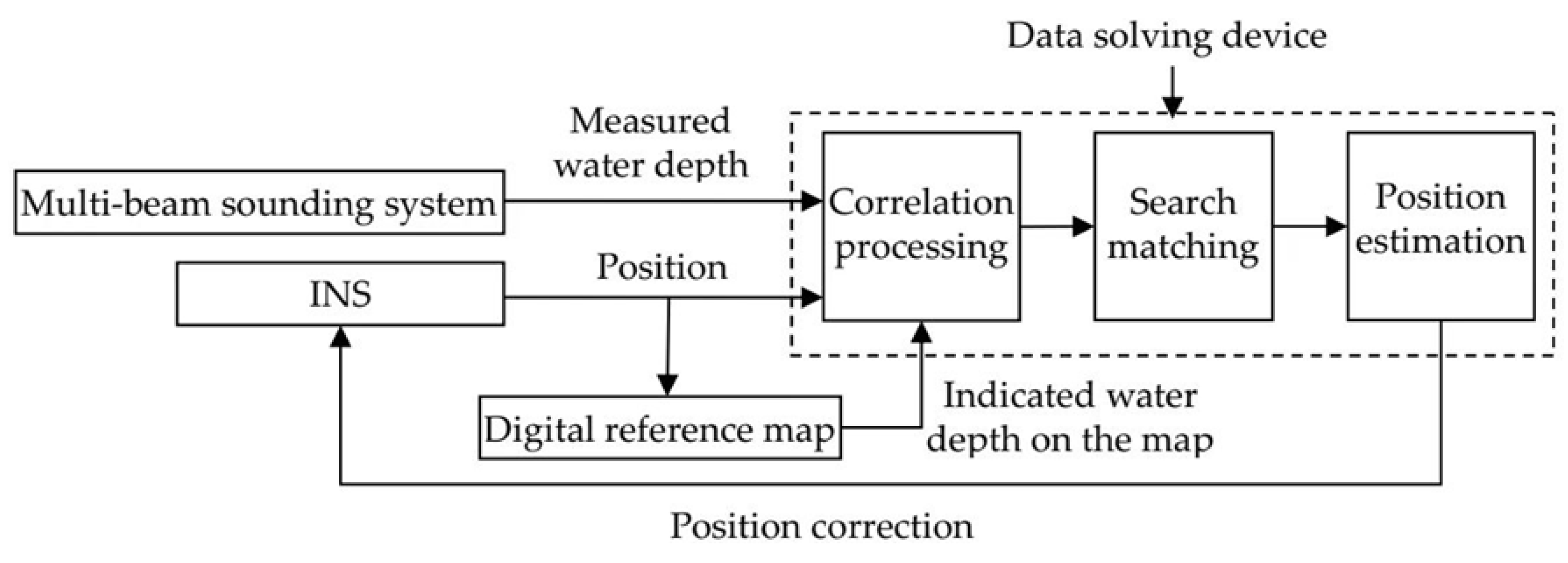
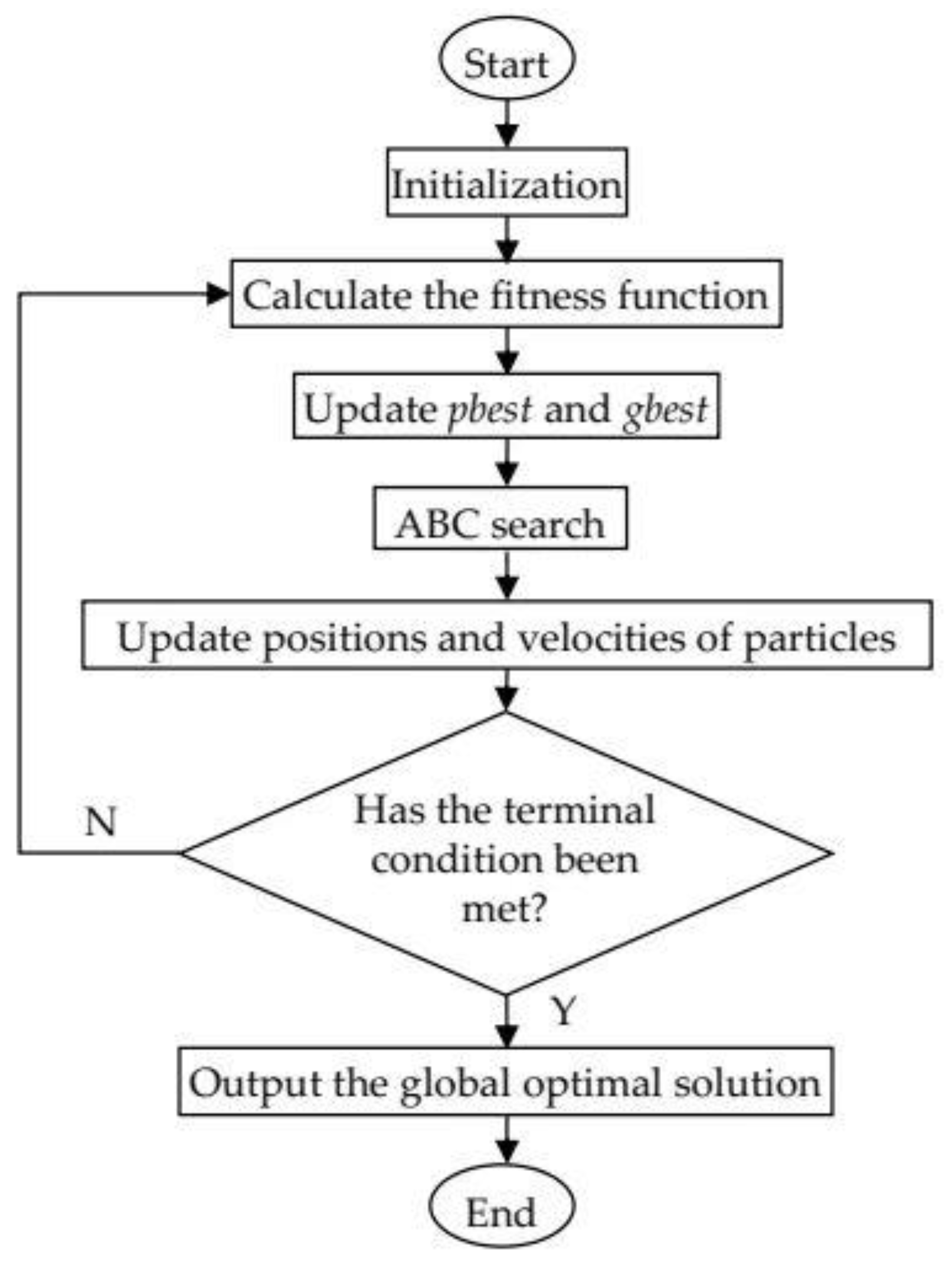

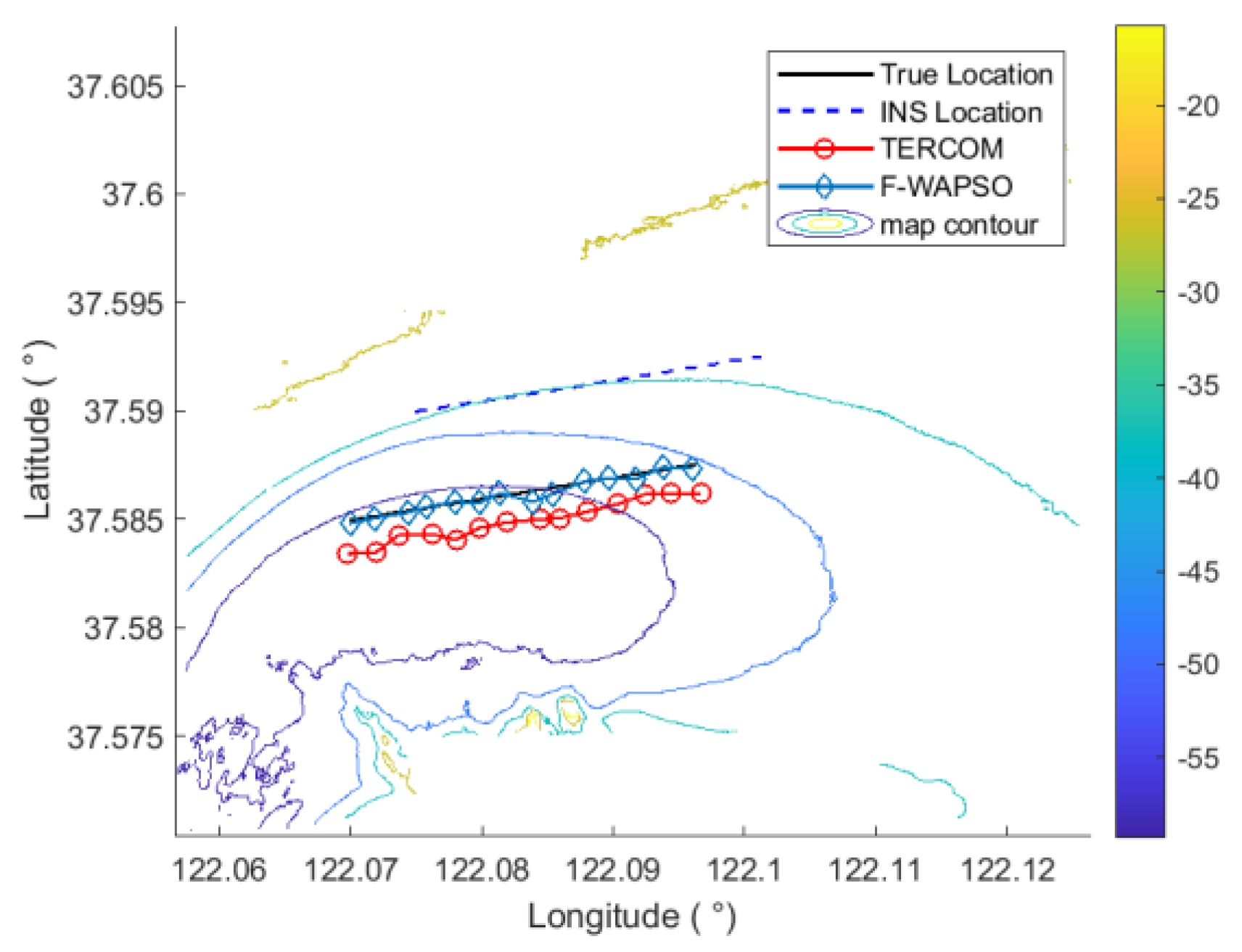
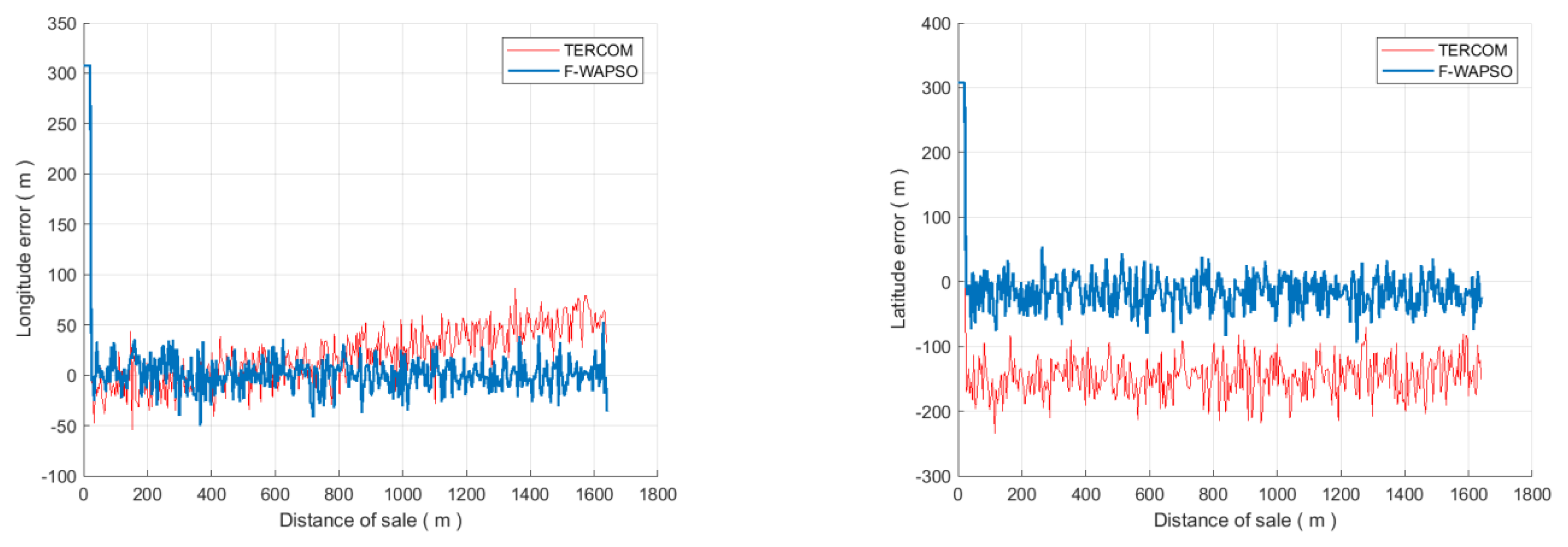
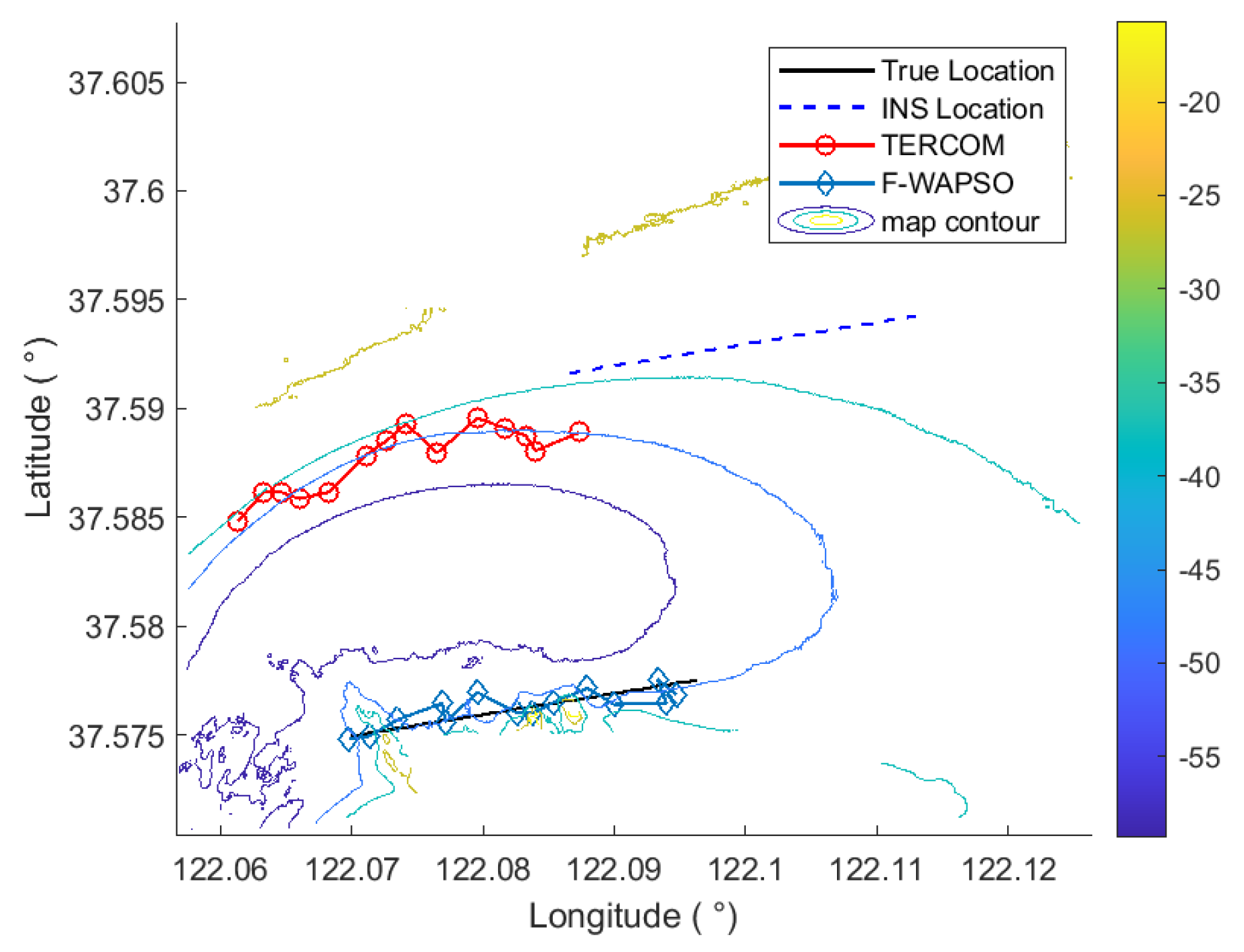

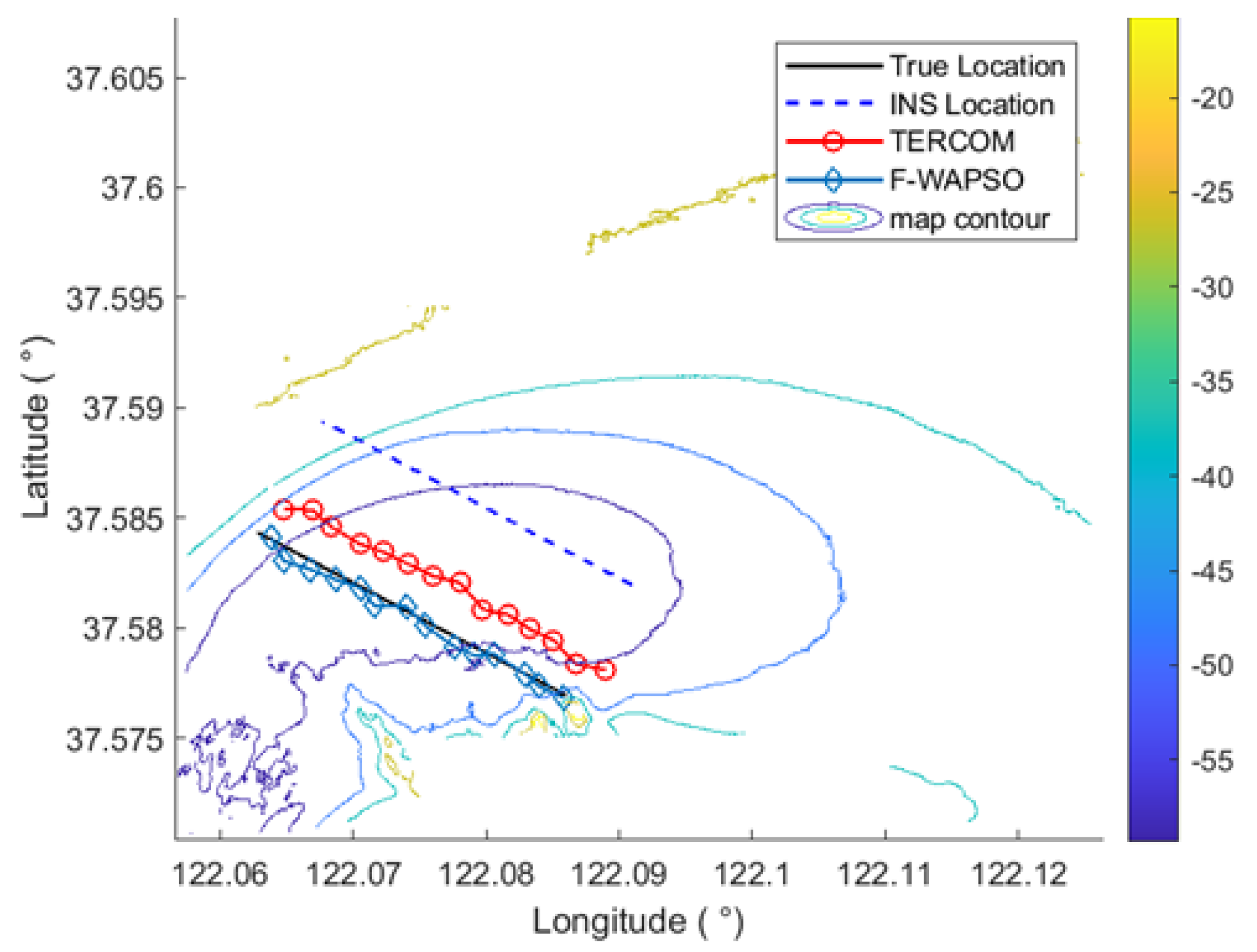
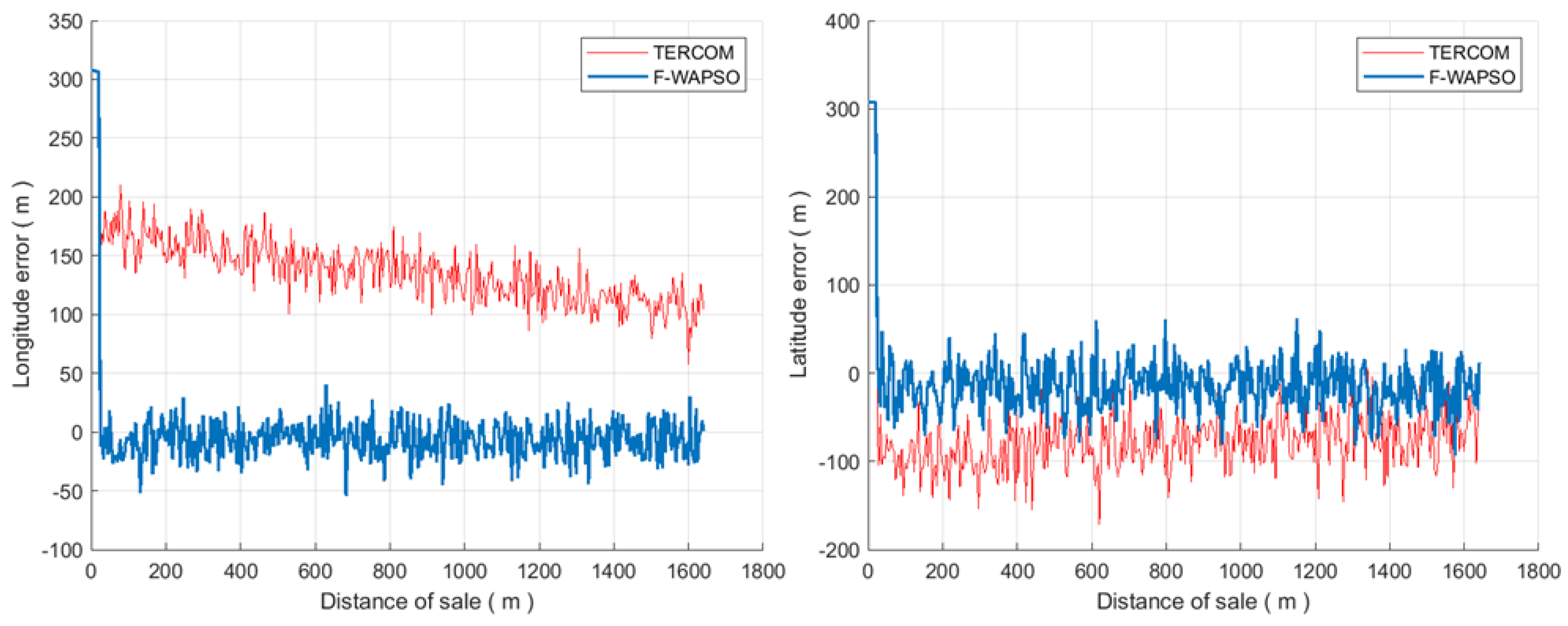
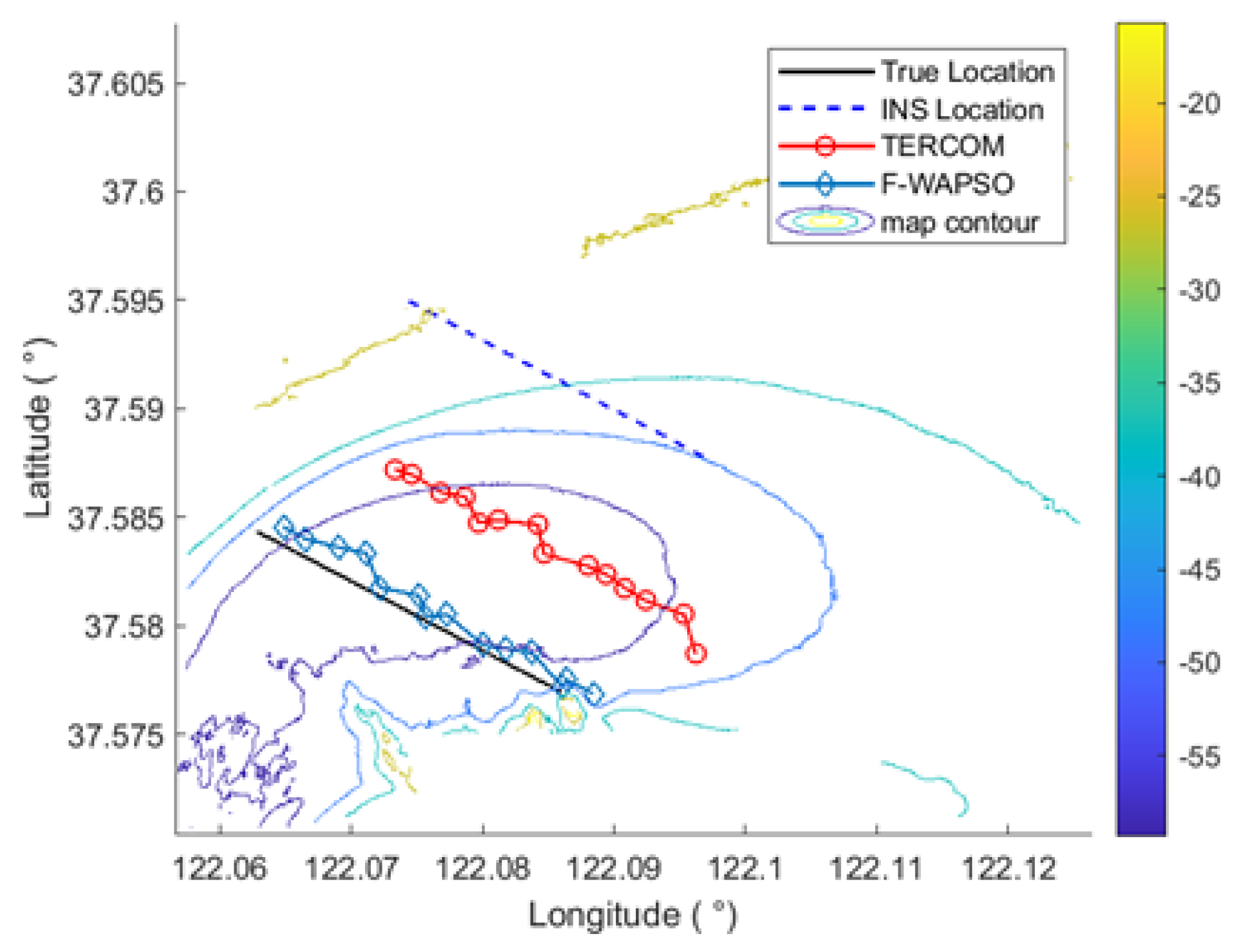

| WAPSO |
|---|
Parameter: , number of particles, , c1, c2
|
| F-WAPSO |
|---|
|
| Matching Algorithm | Initial Position Error | Matching Error (m) | Matching Time (s) | Error of Longitude (m) | Error of Latitude (m) | Error Variance |
|---|---|---|---|---|---|---|
| TERCOM | (300 m, 300 m) | 151.6 | 2.98 | 19.2 | −147.6 | 29.1 |
| F-WAPSO | (300 m, 300 m) | 30.1 | 2.75 | 0.62 | −16.8 | 17.1 |
| Matching Algorithm | Initial Position Error | Matching Error (m) | Matching Time (s) | Error of Longitude (m) | Error of Latitude (m) | Error Variance |
|---|---|---|---|---|---|---|
| TERCOM | (1000 m, 1000 m) | 218.1 | 15.9 | 138 | 168.9 | 63.6 |
| F-WAPSO | (1000 m, 1000 m) | 93.5 | 13.7 | −7.8 | −29.1 | 48.3 |
| Matching Algorithm | Initial Position Error | Matching Error (m) | Matching Time (s) | Error of Longitude (m) | Error of Latitude (m) | Error Variance |
|---|---|---|---|---|---|---|
| TERCOM | (300 m, 300 m) | 144.1 | 4.5 | 129.4 | −53.6 | 23.7 |
| F-WAPSO | (300 m, 300 m) | 33.6 | 3.9 | −16.6 | −27.5 | 18.8 |
| Matching Algorithm | Initial Position Error | Matching Error (m) | Matching Time (s) | Error of Longitude (m) | Error of Latitude (m) | Error Variance |
|---|---|---|---|---|---|---|
| TERCOM | (700 m, 700 m) | 162.5 | 14.9 | −51.3 | 147.6 | 38.5 |
| F-WAPSO | (700 m, 700 m) | 59.7 | 12.6 | −3.9 | 49.5 | 33.6 |
Disclaimer/Publisher’s Note: The statements, opinions and data contained in all publications are solely those of the individual author(s) and contributor(s) and not of MDPI and/or the editor(s). MDPI and/or the editor(s) disclaim responsibility for any injury to people or property resulting from any ideas, methods, instructions or products referred to in the content. |
© 2023 by the authors. Licensee MDPI, Basel, Switzerland. This article is an open access article distributed under the terms and conditions of the Creative Commons Attribution (CC BY) license (https://creativecommons.org/licenses/by/4.0/).
Share and Cite
Wang, D.; Liu, L.; Ben, Y.; Dai, P.; Wang, J. Seabed Terrain-Aided Navigation Algorithm Based on Combining Artificial Bee Colony and Particle Swarm Optimization. Appl. Sci. 2023, 13, 1166. https://doi.org/10.3390/app13021166
Wang D, Liu L, Ben Y, Dai P, Wang J. Seabed Terrain-Aided Navigation Algorithm Based on Combining Artificial Bee Colony and Particle Swarm Optimization. Applied Sciences. 2023; 13(2):1166. https://doi.org/10.3390/app13021166
Chicago/Turabian StyleWang, Dan, Liqiang Liu, Yueyang Ben, Pingan Dai, and Jiancheng Wang. 2023. "Seabed Terrain-Aided Navigation Algorithm Based on Combining Artificial Bee Colony and Particle Swarm Optimization" Applied Sciences 13, no. 2: 1166. https://doi.org/10.3390/app13021166
APA StyleWang, D., Liu, L., Ben, Y., Dai, P., & Wang, J. (2023). Seabed Terrain-Aided Navigation Algorithm Based on Combining Artificial Bee Colony and Particle Swarm Optimization. Applied Sciences, 13(2), 1166. https://doi.org/10.3390/app13021166









